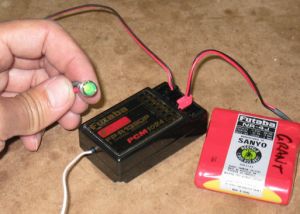Difference between revisions of "Battery eliminator circuit (BEC)"
m (Higher voltage servo comment) |
(Add Malenki which technically has a 3.3v BEC) |
||
| Line 14: | Line 14: | ||
Many [[ESCs|electronic speed controllers]], such as the RobotPower Wasp and the FingerTech TinyESC, include a BEC circuit that feeds 5 volts back to the receiver. The amount of current provided is sufficient to operate a standard R/C receiver, but may be insufficient to operate a receiver with telemetry - particularly when used with a high source voltage. Built-in BECs generally do not provide enough power to operate servos connected to the Rx. | Many [[ESCs|electronic speed controllers]], such as the RobotPower Wasp and the FingerTech TinyESC, include a BEC circuit that feeds 5 volts back to the receiver. The amount of current provided is sufficient to operate a standard R/C receiver, but may be insufficient to operate a receiver with telemetry - particularly when used with a high source voltage. Built-in BECs generally do not provide enough power to operate servos connected to the Rx. | ||
| − | One way to get around this limitation is to use a servo that is rated for the full battery voltage, and powering the servo from that voltage instead of 5 volts. | + | One way to get around this limitation is to use a servo that is rated for the full battery voltage, and powering the servo from that voltage instead of 5 volts. For example, small bots such as 150g weight class can use a Malenki Nano or similar device. It's a combination '''BEC + receiver + ESC''', and any connected motors and servos are run on the full battery voltage. |
=Standalone BECs= | =Standalone BECs= | ||
Latest revision as of 04:52, 31 May 2024
A battery eliminator circuit (BEC) accepts battery voltage and provides a lower voltage for other circuits, such as the receiver (Rx) or the Servos. It is so named because it eliminates the need to have a second "receiver battery" of a different voltage.
How it works
For several decades, most digital electronic circuits were made to operate using a steady 5 volt (5V) supply of power. Few batteries, or combinations of cells, equal exactly 5V, so in radio-control systems the radio receivers (Rx) and servos are forgiving, and may work just fine on as little as 4V or as much as 6.5V.
Unfortunately these circuits can be damaged by higher voltages, and the LiPo batteries used in combat robotics are usually a minimum of 7.4V, with larger battery packs much higher. A BEC is a small voltage regulator circuit connected to the full voltage of the battery, which delivers a steady voltage so that the digital electronics operate correctly. This eliminates the need to use two separate batteries (one for the electronics and another for motors or other devices).
Two types of circuits are used to regulate voltage for a BEC:
- Linear Regulators are simple and inexpensive, but are inefficient as they simply convert excess current into waste heat. Their capacity to provide current decreases with increasing source voltage. Linear regulators are the common type built into Electronic Speed Controllers (ESCs).
- Switching Regulators are more complex circuits that very rapidly turn the source voltage on and off to maintain a stable level, avoiding current waste. Switching regulators are the common type found in standalone BECs.
BECs built into ESCs
Many electronic speed controllers, such as the RobotPower Wasp and the FingerTech TinyESC, include a BEC circuit that feeds 5 volts back to the receiver. The amount of current provided is sufficient to operate a standard R/C receiver, but may be insufficient to operate a receiver with telemetry - particularly when used with a high source voltage. Built-in BECs generally do not provide enough power to operate servos connected to the Rx.
One way to get around this limitation is to use a servo that is rated for the full battery voltage, and powering the servo from that voltage instead of 5 volts. For example, small bots such as 150g weight class can use a Malenki Nano or similar device. It's a combination BEC + receiver + ESC, and any connected motors and servos are run on the full battery voltage.
Standalone BECs
There are several small and light BECs on the market that will provide 5 volts with enough current to run multiple servos and receivers. If you use one of these, be sure to disable the BEC in your ESCs (if any) by using the disable feature or by disconnecting the 5 volt wire from the ESC to the Rx.
Troubleshooting the BEC
- If your Rx is not powered at all (no lights, for instance), make sure there is at least one BEC connected and providing power.
- Avoid connecting multiple BECs to the same Rx, unless they are designed to operate that way. Disconnect all but one 5V supply wire to the Rx. Don't disconnect any Ground wires; they are still needed. Also, don't disconnect the 5V wires that provide power from the Rx to the servo(s).
- If the Rx lights are on, but its behavior is erratic, you may experience temporary or intermittent loss of remote control. Use a voltmeter to measure the voltage across 5V and Ground terminals on the Rx. (Many Rx will also report their voltage back to the transmitter, which can display it on a screen.)
- If the Rx is working correctly, but the servo(s) are not, the voltage may be just low enough (below 4.8V) that most servos will not operate. Consider adding a standalone BEC, or using a servo that can run on a higher voltage, and therefore get its power directly from the battery.
